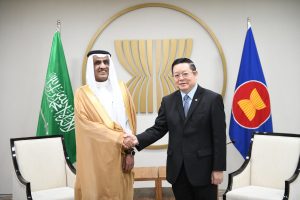On October 20, the Gulf Cooperation Council (GCC) and the Association of Southeast Asian Nations (ASEAN) convened their maiden summit in Riyadh, with the world’s attention focused on the gory conflict between Israel and Hamas in Gaza.
The GCC was founded in 1981 and currently comprises six countries: Bahrain, Kuwait, Oman, Qatar, Saudi Arabia, and the United Arab Emirates. ASEAN was established in 1967 and currently consists of 10 countries: Indonesia, Malaysia, the Philippines, Singapore, Thailand, Brunei, Vietnam, Laos, Myanmar, and Cambodia.
Contacts between the two blocs date back to 1990, and they held their first ministerial meeting in 2009, but had to wait a long time for summit-level cooperation.
The GCC and ASEAN have significant economic ties. Their combined gross domestic product is nearly $6 trillion, accounting for almost 6 percent of the world’s total. At present, the trade volume between the two regions is worth $110 billion, with GCC countries exporting 9 percent of their total goods from ASEAN, and ASEAN products making up 6 percent of their total imports, though this trade volume arguably falls short of its potential. The GCC claims to have invested over $14 billion in the ASEAN region, with the UAE accounting for the majority – 75 percent – of these investments.
The significance of last month’s summit can be gauged from the fact that both blocs began preparing two months in advance. On August 15, a preparatory meeting was held in Riyadh with the participation of the GCC Secretary-General and the ambassadors of ASEAN countries. This summit was significant for a number of reasons.
The first and most obvious is that the summit reflects the two blocs’ desire to diversify their diplomatic and trade partnerships. While the majority of member countries of both blocs have strong ties with the United States, the security role of the U.S. has reduced, particularly in the Middle East, prompting these states to explore new diplomatic avenues.
From this growing cooperation, the GCC can potentially benefit from ASEAN’s economic vitality and global network of relationships, while ASEAN can potentially receive assurances of an uninterrupted supply of Middle Eastern oil and gas. The joint statement issued at the end of the summit reflects a basic unanimity of views on regional issues.
Second, the summit notably steered clear of the U.S.-China rivalry and geopolitical questions, primarily focusing on economic cooperation, investments, and future technologies, and took place regardless of tremors in both regions. The Gulf States’ decision to proceed with the summit despite the outbreak of the Israel-Hamas conflict two weeks earlier demonstrated their determination to advance their national agendas in pursuit of greater regional and global roles. Although the Palestine issue remains significant for the Gulf States, they have avoided allowing the recent outbursts to affect their long-term goals.
Third, the summit stands to benefit both blocs. The accession of all GCC states to the Treaty of Amity and Cooperation in Southeast Asia (TAC) was a diplomatic success for ASEAN. At the same time, ASEAN’s issuance of a separate statement on Gaza proved successful for the Gulf States, especially Saudi Arabia, as many quarters of the Islamic world have expected a strong response from Riyadh.
This was especially noteworthy given that ASEAN’s member states have divergent stances about the Israel-Palestine conflict. Indonesia, Malaysia, and Brunei do not have diplomatic relations with Israel, and are strong supporters of the Palestinian cause. Singapore and the Philippines have good relations with Tel Aviv, while other countries maintain a low-level relationship. The ASEAN statement condemned violence against civilians and demanded a ceasefire and the supply of humanitarian assistance. Above all, the statement called for the two-state solution proposed by the United Nations in 1967. Indonesia, which holds the current chairmanship of ASEAN, and Malaysia, the host of the next GCC-ASEAN in 2025, played a key role in the statement. The statement was considered a triumph for the Gulf States as it aligned with their official position and “internationalized” the issue.
In addition, ASEAN endorsed Saudi Arabia’s bid to host the 2034 FIFA World Cup, while the GCC expressed its cooperation to implement the four priority areas of the ASEAN Outlook on the Indo-Pacific (AOIP): maritime cooperation, connectivity, sustainable development goals, and economics.
Fourth, both blocs prepared a 2024-2028 cooperation framework that aims to enhance the integration of their regional markets, including efforts to implement “sustainability and decarbonization, digital transformation, small and medium enterprises, public‒private sector engagement, and people-to-people ties.”
Fifth, the summit came on the heels of the G-20 meetings, where the India-Middle East-Europe Economic Corridor (IMEC) was agreed to. ASEAN’s westernmost member states are geographically close to India, the starting point of the IMEC. By joining the corridor, ASEAN countries can potentially further deepen their links with the GCC.
Sixth, participating leaders, in particular the summit’s co-chairs, Saudi Crown Prince and Prime Minister Mohammed bin Salman and Indonesian President Joko “Jokowi” Widodo, will gain political advantages. For Mohammed bin Salman, the summit added another feather to his cap. Jokowi will also hope that it will provide momentum ahead of the 2024 Indonesian elections, in which his son is running as a vice-presidential candidate, prompting accusations about a revival of dynastic politics in Indonesia.
Finally, the summit underlines both regions’ growing recognition of each other and a symbolic step toward a more multilateral world. Unlike other regional initiatives such as the Quad and the U.S. “Indo-Pacific” strategy, which were externally imposed or had clear geopolitical goals, the GCC-ASEAN confluence stems from two sides’ natural desire for mutual cooperation. It follows a historical path that traces the two regions’ centuries of economic, trade, and cultural ties. History, geography, mutual interests, and shifts in global power politics are bringing both regions closer. A convergence of Asia and the Gulf, the “Gulf-Asia,” is now emerging as an alternative global power center.

































